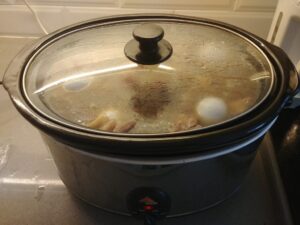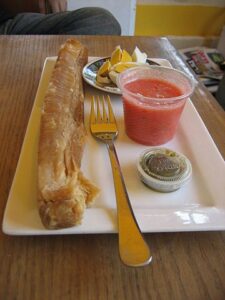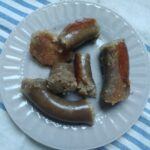Who doesn’t like a bonus? Whether it is extra money from your boss at year’s end or the proverbial cherry on top of your sundae, bonuses put an extra smile on our faces because the base was already good in itself and now we get even more goodness to add to it.
And wouldn’t you know it? Jewish food has a whole category of bonus foods! As I’ve been researching and writing my book about Shabbat stews from around the world, I’ve realized that in addition to the core stew itself, over time many communities have developed special add-ins that cook inside of the stew pot. What makes them different than the other ingredients of the Shabbat stew is that rather than being an integral part of the dish, they are actually designed to be pulled out and served/eaten separately. This, despite being cooked together with everything else. I refer to them in the book as “bonus foods.”
Without going into too much detail about them here (I don’t want to ruin the whole book for you!), I wanted to briefly highlight a number of such bonus foods. One of the fascinating things that you’ll notice is that similar ideas pop up in communities in different parts of the world, underscoring the deep unity of Jews everywhere within our diversity.
The Mother of Bonus Foods
The first such bonus food actually predates the Shabbat stew itself. As I wrote in my article about them for The Nosher, huevos haminados or “hamin eggs” actually started as eggs that were roasted all night and then eaten on Shabbat day. These eggs were mentioned in the Talmud, dating the dish to the 2nd century Galilee. This means that such eggs, as a Shabbat lunch food, are at least as old as the Shabbat stew itself!

This beloved bonus food became standard throughout the Sephardi diaspora, even growing to be cooked for the entire week. The main difference is that while they had been roasted previously, now they would be slow cooked in liquid, even if it was plain water with no stew. Once Sephardim discovered the preferable cooking method, the bonus food continued to be cooked in that method always. Moreover, we encounter these eggs in communities around the world, including some that had less connection to Sephardic culture. Hungarian Jews, for example, often include such eggs in their sólet, despite having only the slightest connection to Sephardic influences. Occasionally they even crop up in chulents from Eastern Europe as well. Maybe this is due to their Talmudic roots, but more likely, when a food is good and logical, it simply crosses all boundaries!
Starchy Bonuses

Interestingly, we find something similar among the Jews of North Africa. A kukla is a small ball of dough that might be made from semolina, soaked bread, or various other grains. Often it will be flavored with spices or herbs, and sometimes it might even have some meat mixed with the starch. Some people make a number of small kuklas for their Shabbat stew, while others will include one large one in the pot.
A Kurdish maboseh is not complete without the inclusion of kubbeh inside. A whole class of foods made via different cooking methods (fried, baked, stewed, etc.), kubbeh essentially encase flavored ground meat in some kind of grain exterior. They are widely eaten as a stand-alone food (particularly the fried kubbeh nablusa or the baked kubbeh bil siniyah, but also are sometimes served inside of various soups. This latter variety is typically made using a thicker shell of semolina dough, and they are the main type to find their way into the maboseh. Thus, this “bonus food” is of a slightly different variety; they are less likely to be removed from the stew and served separately. Still, their similarity to both mini-kugel dumplings and kukla suggest that they really do fall into the bonus food category.

Meaty Bonuses
The kukla that included chopped meat has a close Moroccan relative that is more meaty. Alternately called tamra, sara, or kora, it mixes meat with ground nuts, along with spices and sometimes a starch as well. It is typically formed into a long roll or meatloaf shape, and wrapped in a cheesecloth or similar container. Then it can be served as slices, once taken from the stew pot. The one thing that removes this slightly from being considered a bonus food is that typically a Moroccan dafina or skhina is served entirely in separate parts. The grain is cooked in its own bag inside the stew as well, and is served in a separate dish as are the meat, vegetables, and haminados. Still, the unique preparation and serving method places tamra, to my mind, in the category these other foods fall into.

They also remind us of the last bonus foods I’ll discuss, ones that hybridize starchy and meaty. Emerging from Eastern and parts of Central Europe, two popular bonus foods are kishke and helzel. They are essentially similar foods, with one slight difference. Kishke stuffs intestines (at least originally, while now it will often be made in artificial cellulose casings), while helzel instead stuffs the neck skin of poultry. Originally goose neck would be most popular for this bonus food, but now turkey, or even occasionally chicken necks, are more common. What differentiates these from the previous examples is the stuffing. These Ashkenazic bonuses used a very basic dough to fill the animal parts, rather than meat. Flour, corn meal, grated potatoes, or a combination would be mixed with onion and some very basic spices, then stuffed into the casing and placed inside a pot of chulent. They added bulk and caloric content to the stew, while also soaking up the flavor of the meat and vegetables around them.
As the Shabbat stew developed and traveled with the Jews on their international peregrinations, it changed ingredients and took on many new flavors as it became elaborated. One of the overlooked changes, however, is the development of the bonus food class. These foods began as extras cooked within a Shabbat stew and served as a side dish, but most have by now grown to be well-liked stand-alone dishes. In addition to arguably being the most Jewish food there is, the Shabbat stew has also produced many more Jewish gastronomic favorites!






